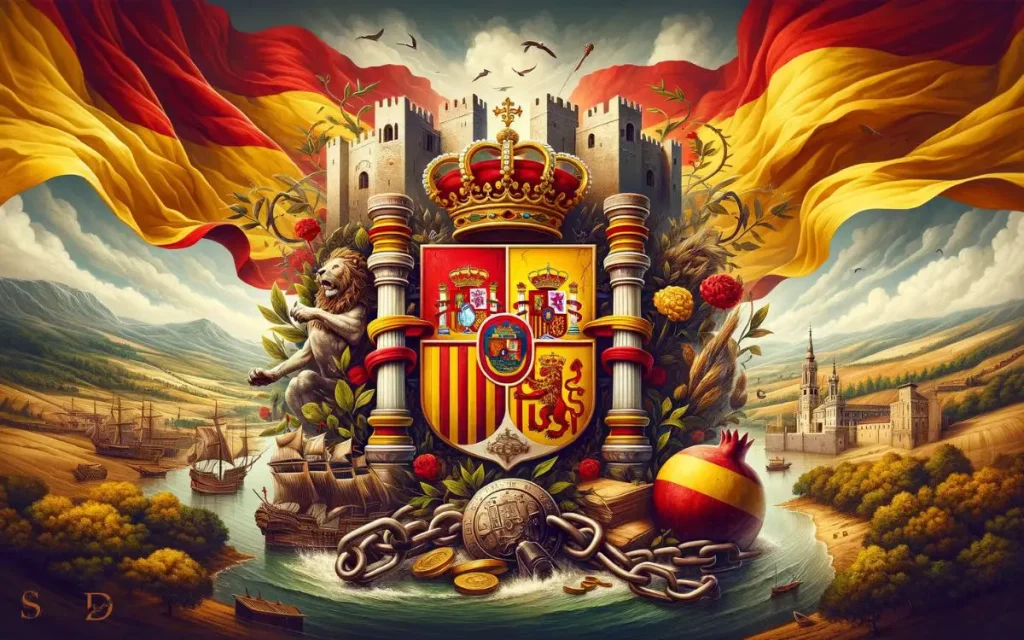A Glimpse at the Spanish Flag’s Design
The current national flag of Spain features three horizontal stripes: two red stripes sandwiching a wider yellow stripe in the middle. On the left side of the yellow stripe, the country’s coat of arms is proudly displayed. The proportions of the stripes, with the yellow one being twice as wide as the red ones, create a bold, striking look that is visually distinct and instantly recognizable.
The Coat of Arms: What It Stands For
At the heart of the flag is the intricate coat of arms, which carries deep symbolism from Spain’s various historical regions. The coat of arms includes:
- The Pillars of Hercules: These represent the ancient mythological boundaries between Europe and Africa, specifically the Strait of Gibraltar. Draped with a banner inscribed with “Plus Ultra” (meaning “More Beyond”), this is a nod to Spain’s global exploration and colonial past.
- The Royal Crown: This symbolizes Spain’s monarchy, which has been a central part of its government and culture for centuries.
- The Shield: Divided into four quadrants, each symbolizing one of Spain’s key historical kingdoms—Castile, León, Aragon, and Navarre. The pomegranate at the bottom represents the Kingdom of Granada.
Each part of the coat of arms reminds Spaniards of their historical roots, uniting them under a common national identity.
Historical Evolution of the Spanish Flag
Spain’s flag has undergone numerous changes throughout its history, reflecting political shifts and evolving national identity. The current flag design was officially adopted on December 19, 1981, but its origins trace back to earlier centuries.
- The Bourbon Dynasty Flag (1700s): When the Bourbon dynasty came to power in Spain, the country used a simpler white flag with the royal coat of arms. However, the flag’s similarity to other European flags at sea (particularly France) caused confusion.
- The Naval Flag (1785): King Charles III of Spain wanted a flag that was easily distinguishable at sea. This led to the introduction of the red and yellow flag design, which was first used by the Spanish navy. The vibrant colors allowed ships to be easily identified from a distance.
- Franco Era Flag (1939-1975): Under Francisco Franco’s dictatorship, the flag underwent some adjustments, including a different version of the coat of arms that reflected the regime’s symbolism.
- Post-Franco Democratic Flag (1981): After Franco’s death and Spain’s transition to democracy, the flag returned to its traditional roots, with a revised coat of arms to symbolize unity and the new era of democracy.
Symbolism of the Colors
The red and yellow colors of the Spanish flag are not arbitrary. These colors were chosen for their strong connection to Spain’s heritage. Historically, red and yellow were prominent colors in the shields and flags of Spain’s various medieval kingdoms. The color red is thought to symbolize strength and valor, while yellow stands for the richness and generosity of the land.
Interestingly, some people also interpret the colors in a more dramatic way. For instance, some view red as representing the bloodshed during Spain’s wars and revolutions, and yellow as symbolizing the sun that bathes the country in light and warmth. While these are more poetic interpretations, they reflect the emotional connection Spaniards feel toward their flag.
The Flag in Modern Spain
Today, the Spanish flag is a symbol of unity, representing the entire nation, despite its regional diversity. Spain is made up of 17 autonomous communities, each with its own culture, language, and identity. While some regions, like Catalonia and the Basque Country, have their own flags and strong regional identities, the national flag serves as a unifying symbol for the country as a whole.
You’ll see the Spanish flag flown proudly at public institutions, government buildings, and during national holidays like Día de la Hispanidad (National Day of Spain), celebrated on October 12th, which marks Spain’s connection to the Spanish-speaking world.
Conclusion
The Spanish flag, with its striking red and yellow colors and detailed coat of arms, represents more than just the country’s geographical boundaries. It symbolizes Spain’s historical evolution, the unity of its diverse regions, and the pride of its people. Whether flying above government buildings, carried by sports fans, or waved during parades, the Spanish flag is a powerful reminder of the country’s rich history and enduring spirit.
FAQs
- When was the current Spanish flag adopted? The current design of the Spanish flag was adopted on December 19, 1981.
- What do the colors of the Spanish flag represent? The red represents strength and valor, while the yellow symbolizes the richness of Spain’s land and resources.
- What does the coat of arms on the Spanish flag signify? The coat of arms includes symbols of Spain’s historic kingdoms—Castile, León, Aragon, Navarre, and Granada—as well as the Pillars of Hercules and the royal crown.
- Why does Spain’s flag have the Pillars of Hercules? The Pillars of Hercules, a mythological reference to the Strait of Gibraltar, symbolize the limits of the known world during ancient times and Spain’s role in exploration and discovery.
- How has Spain’s flag changed over time? The flag has evolved over centuries, reflecting changes in the monarchy, governance, and political shifts, with its modern form being solidified after Spain’s transition to democracy in 1981.

